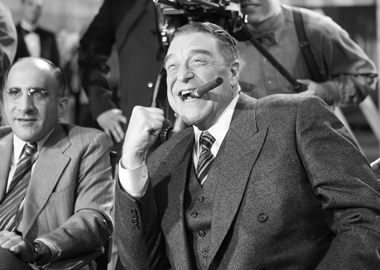We all have our own end-of-year holiday traditions, and the film industry is no exception. We give gifts; Hollywood and its companions give us their Oscar hopefuls, dreaming, instead of sugar-plum fairies, of golden statuettes and fabulous blurbs on the posters for their next movies. With the awards season coming in winter, viewers can’t be trusted—the prevailing wisdom goes—to remember a big film for more than a couple of months. And so as the year winds down, film winds up.
This year, one of the most talked-about films—already appearing on many Best Of lists for 2011 despite a smallish release—is The Artist, director Michel Hazanavicius’ ode and homage to the wonder of a bygone age of filmmaking and the technical advances that brought about its end. The story of an American silent-movie star in the age when the talkie was born, it is both historical melodrama and modern reflection. It is also—in a twist both shocking and totally appropriate—a silent movie.
The film stars Jean Dujardin as George Valentin, a swashbuckling star in the Douglas Fairbanks mold: he is the veteran of a clutch of popular films that pair him with a trusty Jack Russell terrier in the fight against injustice. Dujardin, watching himself onscreen, reminds us of what a magical experience cinema was in its early years; as much as any fan, his Valentin is entranced by the movies. (Along with nods to other touchstones, there are shades of Sunset Boulevard.)
He meets his perfect co-star in Peppy Miller (Berenice Bejo), a young woman who stumbles (literally) into an acting career when she and Valentin collide at a post-screening autograph session. It’s the beginning of a relationship that will chart the momentous change about to hit the industry: as Peppy lands bigger roles, her own star grows brighter, eventually overtaking Valentin’s reflected glow. But what finally reverses their standing is the introduction of talking pictures. When studio chief Al Zimmer (John Goodman) shows Valentin a test screening, his star remarks, “If that’s the future, you can keep it.” Peppy decides she will.
One of the most surprising things about this movie is its originator: Hazanavicius is mostly known as the director of a series of James Bond spoofs (the OSS 117 movies), and arrived in Hollywood to shoot The Artist with only his cinematographer and stars along for the ride (it was shot in Los Angeles and uses English intertitles). But if his isn’t the first name that comes to mind when you picture a reworking of the silent genre, the result erases any doubt about his deep love and understanding of what makes the best cinema truly transporting—that though we’ll never go back to the pre-talkie days, movies remain primarily a visual medium, and that the right images, strung together, can create a story that says much more than mere words could ever manage.
*
Also this week: Amherst Cinema screens Mozart’s Sister, director Rene Feret’s speculative story of Maria Anna “Nanneri” Mozart, older sister to Wolfgang Amadeus and a talented musician in her own right. Dragged across Europe by their father to perform for royal courts, Maria finds her spotlight fading as attention turns to her brother. As she approaches marriageable age, her father demands that she give up her violin and forbids her to compose music, lest a suitor think it improper. As she struggles to thrive, she finds relief in a friendship with the children of Louis XV.
And at Pleasant Street Theater, the 1984 hit Gremlins comes to town for a midnight screening on Friday, Dec. 23. It’s hard to imagine a more timely booking: Joe Dante’s horror comedy is about a cuddly creature bought as a Christmas gift that transforms into a reptilian wreaker of havoc when fed after midnight. Keep an eye on your Jujubes.
Jack Brown can be reached at cinemadope@gmail.com.



